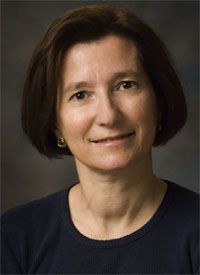Expert Addresses Increased Incidence of Secondary Malignancies in Patients With CLL
Alessandra Ferrajoli, MD, discusses the challenge with secondary malignancies in patients with CLL.
Alessandra Ferrajoli, MD

Alessandra Ferrajoli, MD
Patients with chronic lymphocytic leukemia (CLL) have an increased likelihood of developing secondary cancers and other diseases, often based on their age and gender, explains Alessandra Ferrajoli, MD.
“Care for patients with CLL needs to be global,” says Ferrajoli. “By global, I refer to the fact that they need to be carefully evaluated for other medical conditions besides CLL. There needs to be particular attention toward active surveillance for any kind of cancerous lesion or precancerous lesion, and they need to be reminded of how important it is to focus on their general health.”
In an interview withTargeted Oncology, Ferrajoli, a professor of Medicine in the Department of Leukemia at The University of Texas MD Anderson Cancer Center, discussed the challenge with secondary malignancies in patients with CLL.
TARGETED ONCOLOGY:What were the key takeaways of your recent presentation on other cancers in patients with CLL?
Ferrajoli:
We reviewed the fact that patients with CLL have a higher incidence of other cancer types than the same type of people in the general population based on their age and gender. We also reviewed the fact that these cancers are often more aggressive in their behavior when they affect an individual with CLL.
We reviewed the most common ones. We discussed the very high frequency of skin cancerboth melanoma and nonmelanoma type. We reviewed which ones are the ones that tend to come after treatment and possibly are related to chemotherapy, and those include the myelodysplastic syndromes. We also discussed what can be done to prevent these cancers or, if not to prevent them, to diagnose them at a very early stage.
We discussed the importance of avoiding excessive sun exposure, the use of sunscreen, and the requirement to go at least once a year to see a dermatologist and be examined. We also explained the importance of doing what is routine health maintenance with colonoscopy, mammogram, and other types of testing.
Toward the end of our presentation, we also touched on the research that is being done in this field. How much of this tendency to develop other cancers is due to the immunosuppression that comes with the diagnosis of CLL? How much can we do to viral diseases that can affect these patients? What is the contribution of health-related issues such as smoking, alcohol, or chemical exposure and increasing the risk toward these types of cancers?
TARGETED ONCOLOGY:What related studies are ongoing now?
Ferrajoli:
There are several groups that are looking at the incidence of other cancers. They are comparing them with cancer in the general population and, within the cancers with CLL, which ones are more predisposed to them.
In our institution, we are doing several initiatives. We are doing an initiative to sensitize the importance of some protection. We are also doing an initiative in encouraging the patient to adopt a healthy lifestyle and exercise. There are some data that indicate that this actually improves your immune system when you have the ability to live healthy and exercise. We are also doing some other studies that are much more in-depth in the field of translational studies, where we look at the genomic components of the patients with CLL and other cancers.
TARGETED ONCOLOGY:What do you see on the horizon in the next 5 to 10 years?
Ferrajoli:
I see the problem of other comorbid conditions; in particular, cancer is becoming more and more important for the patients with CLL. That is because our treatments are so successful and we have so many of them. We are at the time of wealth that patients live much longer.
We all know that [with] living longer, [there] are factors that predispose you to develop other cancers. Therefore, there is a very positive messagethat is we think our patients are going to live a long time. However, this needs to be associated with another message that says you need to be careful for anything else that could prevent you from reaching an older age.
TARGETED ONCOLOGY:What should oncologists tell their patients to do in terms of exercise and diet?
Ferrajoli:
In terms of a complete diet, there are really no other suggestions. In terms of exercise, we do recommend to exercise every day, if possible. If not, at least 3 days a week and it should be an exercise that is done to an intensity that is based on your level of fitness.
However, it should be an exercise that is done on a schedule. A common conversation with patients is that it is better to go to a gym or to join some kind of exercise activity versus exercising at home on a treadmill. This is because whenever things are done on your own schedule, they’re unlikely to happen. Additionally, our body benefits more when exercise is done at a certain time of the day with a specific level of intensity and duration.
TARGETED ONCOLOGY:What major challenges in CLL are oncologists still facing?
Ferrajoli:
I really would like all patients with CLL to see a dermatologist on a yearly basis. They should report on if they have any kind of skin lesion removed and what the diagnosis was. They need to be very proactive and take charge of keeping a schedule for their health maintenance and requirementbeyond colonoscopy, prostate checks, and mammograms.
However, they need to be sure to receive their annual flu immunization and follow the schedule for the pneumonia immunization. They should also contact us if they travel abroad to certain countries and review which precaution they should take. I want the patient to become the driver and sit in the driver seat in their health maintenance.